In business, project success mirrors the organizational culture in which it operates. Projects are more than just tasks – they drive strategic growth and innovation when supported by effective project management practices.
This article explores the symbiotic relationship between organizational culture and project management. It highlights why a supportive culture is essential and outlines four strategies to establish effective project management that allow you to align your team’s efforts with your mission.
You will learn how to foster a culture that values project management and excels at it, ensuring your projects contribute positively to your company’s objectives.
Collaborate on projects in one place with Microsoft Teams and BrightWork 365
Work seamlessly from anywhere, with BrightWork 365 and Microsoft Teams.

What is organizational culture?
Organizational culture describes the personality of a company and influences how employees work and interact with each other.
Culture helps an organization reach strategic goals by encouraging desired behaviors, attitudes, and working methods.
Although difficult to define, organizational culture typically encompasses:
Consistent, observable behaviors
The routine actions that set the standard for what is expected within the company.
Work ethics
The values that guide employees’ approach to their work, such as commitment and integrity.
Codes of conduct
The formal rules that define professional behavior and establish workplace standards.
Incentives and reward systems
The structures that recognize and incentivize employee performance in alignment with company goals. A strong governance culture is essential for project success, as it reinforces management practices that align with the organization’s strategic objectives.
A shared sense of purpose and action
The common understanding of the company’s mission motivates collective effort.
Leadership styles and management practices
Research shows that leaders’ methods to guide, influence, and inspire their teams can significantly affect project outcomes.
Communication patterns and information flow
How information is shared within the organization affects transparency and collaborative culture.
Decision-making processes
Organizational culture significantly shapes decision-making processes, reflecting a company’s values and strategic priorities.
A recent study highlights the impact of culture on project planning, underscoring the need for alignment between projects and organizational values.
Adaptability and response to change
The organization’s capacity to adjust to new challenges and market conditions.
Employee engagement and participation
The level of employee involvement in and enthusiasm for their work and the company’s vision.
Culture constantly evolves, making it hard to change through a formal program or effort. That said, there are some steps you can take to make positive changes to a culture that supports your project management, which we’ll cover later on.
Why is organizational culture important to projects?
Organizational culture is the framework in which a project manager and team must work. It’s the bedrock that supports all project-related activities and decisions.
All elements of a project – from processes to leadership, project management styles, communication, risk tolerance, and project request management – are influenced by cultural norms in your company.
A shared belief in the value of project management and a willingness to invest in project processes are critical to a strong project management culture.
This is corroborated by this study on the impact of organizational culture on the financial performance of a company, highlighting its importance to the company’s project activities and long-term success.
Drives performance and efficiency
A strong project management culture based on clear communication is pivotal for performance and efficiency.
This study reveals that organizations with supportive and robust project management practices achieve their goals more effectively. These organizations operate with greater financial efficiency, wasting less money than low-performing organizations.
This success stems from valuing clear goals, streamlined processes, and effective resource management, ensuring project deliverables are completed on time and within budget.
Shapes project selection
Culture is a vital point of differentiation between these types of organizations. It influences the types of projects executed by a company. Ideally, all projects should be aligned with strategic goals.
A strong project culture often reflects the foundational values and norms shaping a company. This alignment helps select projects that appeal to project stakeholders and meet the needs of external customers.
Fuels motivation through cultural alignment
When employees see their role in the broader narrative of the company, they are more engaged and motivated. Recognizing the value of their work and its impact on the company’s success fosters a sense of belonging and purpose.
This alignment with the company’s culture and common goals drives employees to invest more deeply in their projects, boosting morale and productivity.
How to build a strong project management culture
Changing organizational culture is notoriously difficult. Many organizations try to change everything at once and fail to translate the new vision into practical steps for their employees.
Culture is shaped by actions, behaviors, and actions. Start with a step if you want to make a lasting change to improve project outcomes. People tend to act their way into new behaviors before changing their mindsets.
Here are four practical ways to build a strong project management culture.
1. Choose your project management approach
I’m sure you can think of many elements of project management you’d like to change within your organization!
You need to be rigorous and realistic when picking a behavior. Introducing a standardized approach to project management is an excellent place to start.
Often, individuals tasked with managing a project – including project leaders who need formal training in project management abilities – will develop their own project rules. This can lead to a lack of consistency in project execution across the organization.
Adapting to organizational needs
Without a straightforward approach, individuals will get creative and develop their ways of working, leading to multiple styles in one organization!
Below is a project management spectrum we use with our customers.
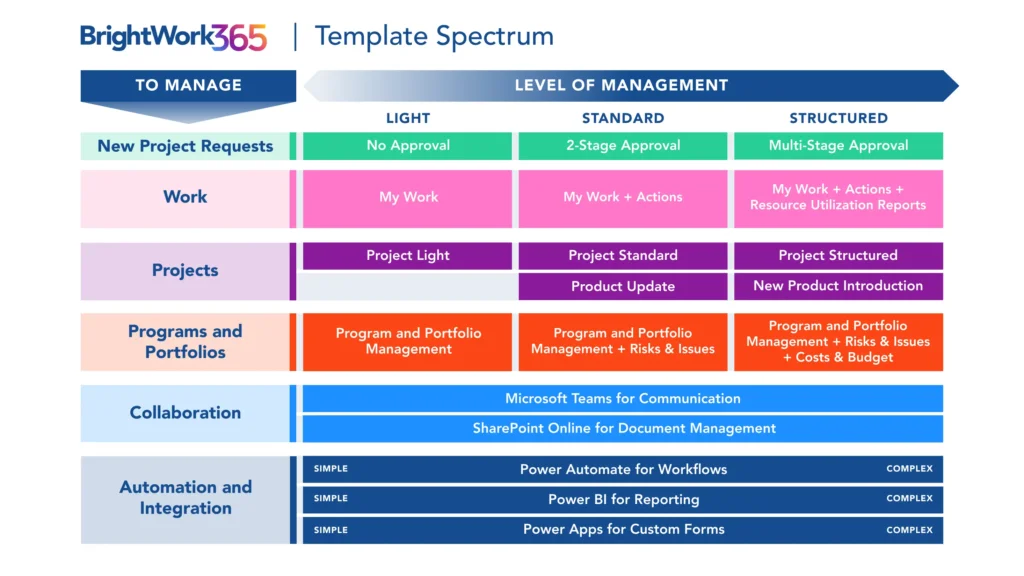
As depicted, some projects require a lighter touch, while others need more rigorous project management processes. The choice will depend on project maturity levels within your organization, the number of projects, the complexity of projects, the duration of projects, etc.
When picking your approach, you should consider how projects are currently managed and what practices should be kept, such as weekly team meetings or collaborative planning sessions. Don’t make changes just for the sake of change.
2. Select the right project management tool
Next, you’ll need to make it easy to translate the new process into actionable steps for your team. Update relevant project management templates and software as required or find new software is required.
For instance, our Microsoft 365 project management software can integrate seamlessly into your workflow.
Focus on practical, role-based training to help your team understand how the software supports their role. The new solution must be easier to use or, in some cases, worth extra effort for team members.
Maximizing existing infrastructure
Many organizations worldwide are already using Microsoft 365 for productivity and collaboration. BrightWork 365 integrates the best Microsoft 365 apps, such as Power Automate for workflows, Power Apps for project management, Teams for collaboration, etc., into project management templates.
These templates can be a practical starting point for individual projects. The pre-designed project sites are easily used and mapped to a suitable project management process.
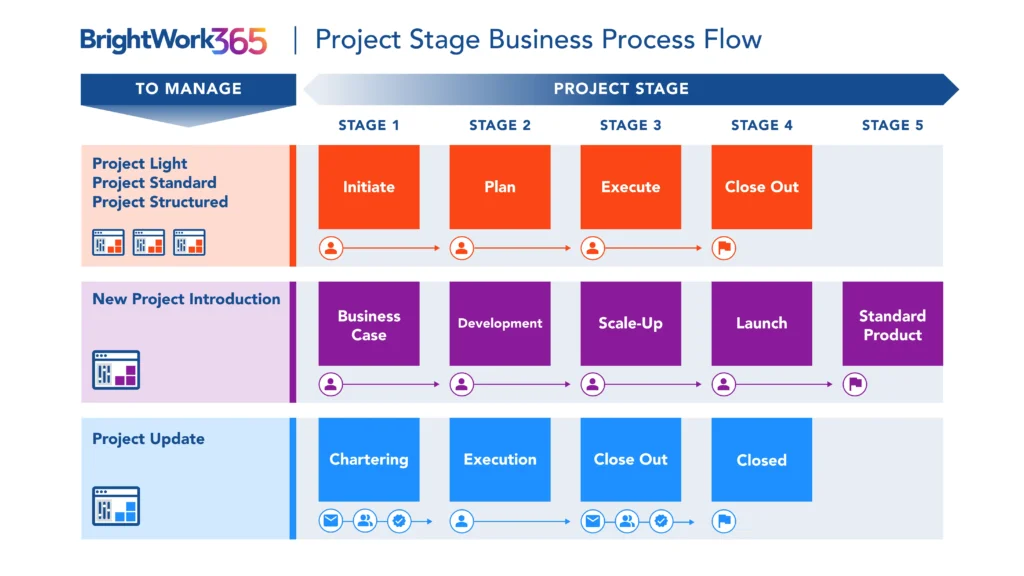
Streamlining portfolio management
Managing across different portfolios is a breeze with tools like Microsoft 365 and Power Platform project management, as it features everything you need, including templates, dashboards, and project request management.
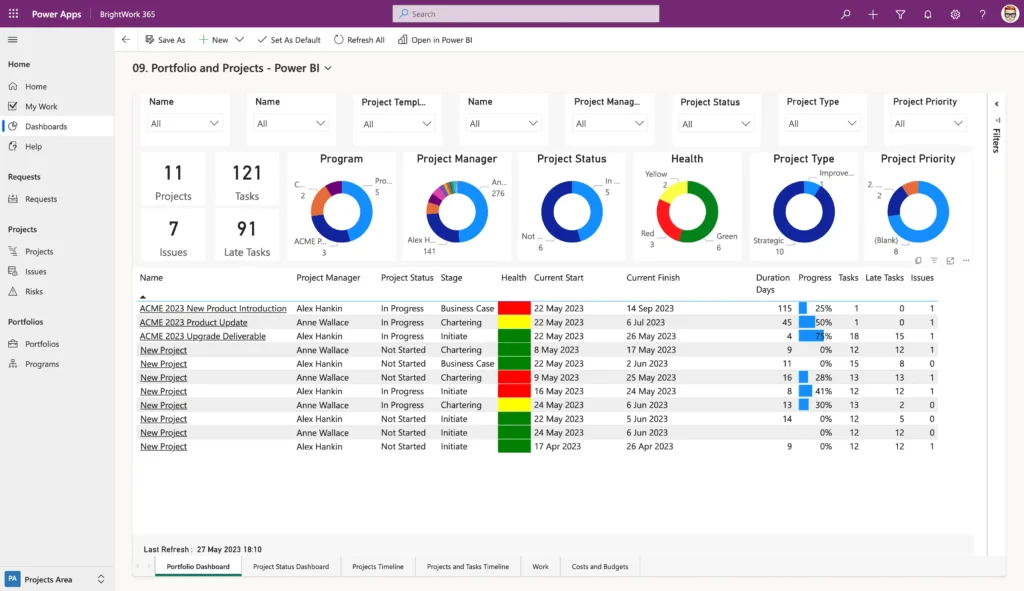
3. Measure and report performance
Demonstrating tangible business and project outcome improvements is critical to driving new behaviors.
People need to know that their efforts contribute positively to projects and the organization; otherwise, they will become disillusioned with your project leadership skills.
Identifying key project metrics
Pick a few project metrics to improve with your new process and report on these on your project site. Does your team struggle to track project tasks and meet deadlines? Do issues fall through the cracks as no one knows how to report a problem?
Are documents stored in multiple locations, leading to confusion? Regular project review meetings can help address these issues by fostering a concerted effort toward project success.
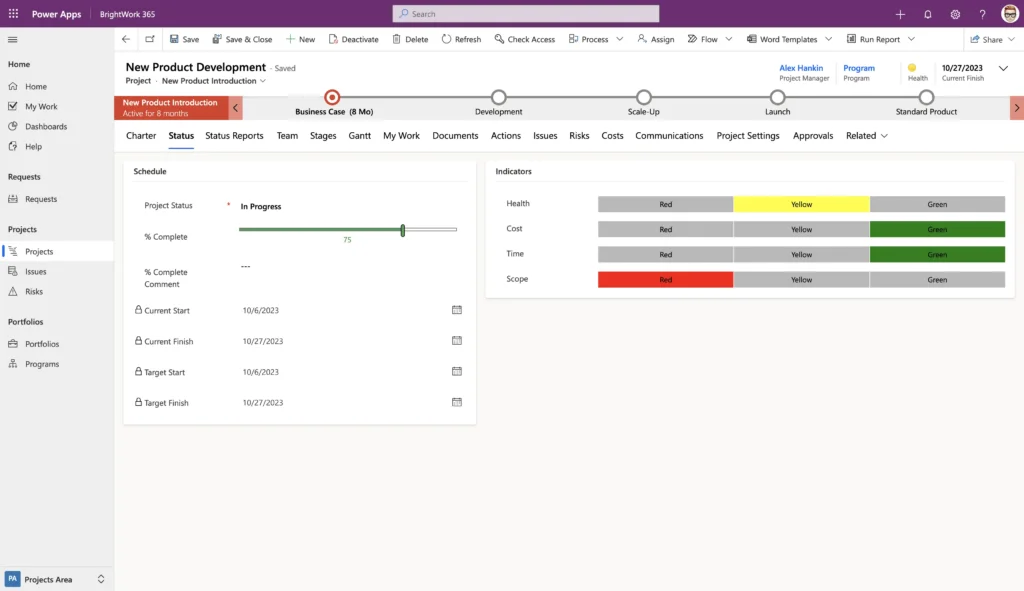
Demonstrating impact through reporting
Report on these project metrics during weekly team meetings to demonstrate impact quickly. The SharePoint Project Management Template ships with valuable reports, including:
- Task completion: Tracking and reporting on task progress and completion rates.
- Issue resolution: Monitoring how quickly and effectively issues are identified and resolved.
- Workload management: Reporting on open, overdue, upcoming, and unassigned work to ensure balanced distribution.
- Metric tiles: Visual representations of critical metrics for at-a-glance insights.
- Project status updates: Regular updates on the overall health and progress of the project. These reports can be significantly enhanced using Microsoft Teams apps for project management, facilitating communication and collaboration.
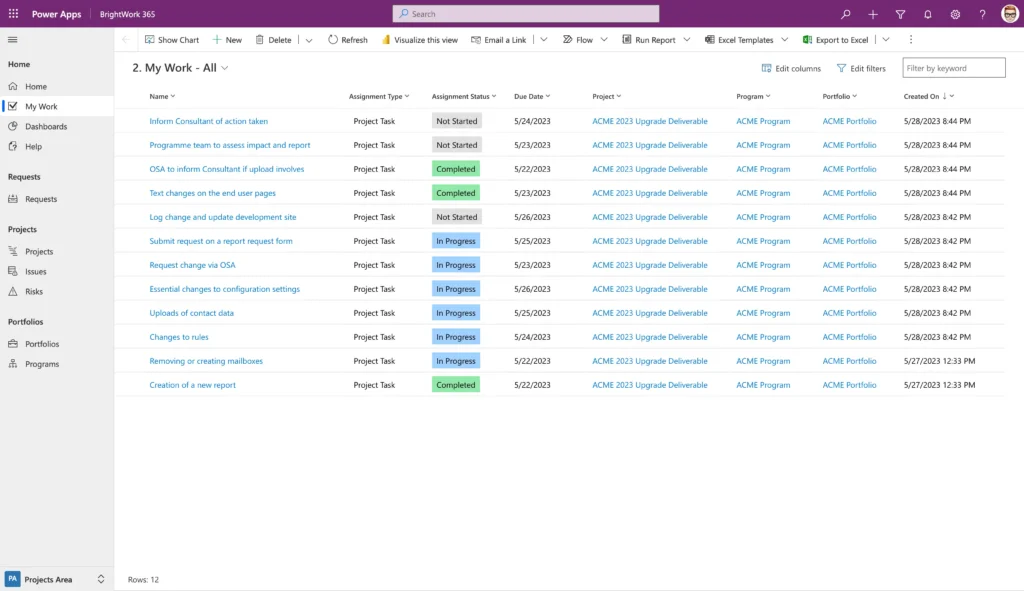
Communicating value to the company
It would help if you also considered how improvements in these areas add value to the company – more projects finished on time, increased stakeholder satisfaction, and effective teams. These benefits will likely become apparent after a project is completed.
Sharing post-project success
Set a reminder to get the outcomes and share them with the project team members and company a few weeks after the completion date.
Send an email, share an update on your intranet, talk to people at meetings – just get the word out!
4. Get leadership involved in the process
People tend to mimic the behavior of individuals or groups who influence an organization. If your team sees senior management acting differently from you regarding project management, they’ll no longer follow your efforts.
Find someone to act as a “Project Management Champion” to secure senior management buy-in. This champion should be well-versed in project management critical success factors that can drive your project management culture forward.
This person often plays a critical aspect in shaping the project management culture and can influence the project leadership team to adopt principles of project management that steer away from potential project failures.
How BrightWork can help you implement a project management culture
At BrightWork, we implement successful project management using the “Start, Evolve philosophy.”
This method encourages beginning with a manageable scope of project management practices that allow teams to achieve early success. Start as many projects as you want with the right amount of project management.
Project teams can handle more projects with a simpler approach initially, gaining visibility and control without being overwhelmed by complex processes. This sets the stage for the gradual evolution of their project management practices.
BrightWork 365 for evolutionary growth
BrightWork 365 offers project, portfolio, and request management templates. It also includes deployment assistance to ensure smooth integration into your workflow.
The 3D deployment approach
“Start, Evolve” is an integral part of our 3D deployment approach, using tools like Microsoft Teams for project management to promote communication and collaboration.
The 3D Deployment approach is based on the following three principles:
- Design: Utilizing collaborative project management best practices.
- Deliver: Beginning with configurable templates that cater to various project needs.
- Deploy: Offering on-demand and as-needed training to ensure effective adoption.
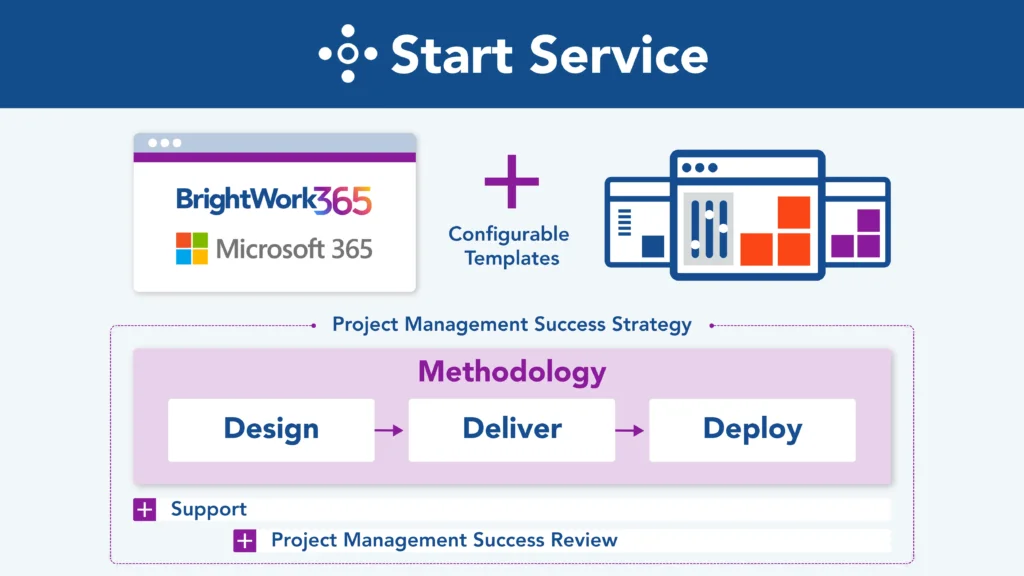
Our 3D Deployment Process is a clear, transparent, and practical change management plan focused on your needs. It is designed to help you implement collaborative project and portfolio management effectively.
Summary
Organizational culture shapes how teams collaborate and succeed in project management. A supportive culture is vital for growth, lowering operating costs, improving efficiencies, and achieving strategic objectives. The four ways to cultivate a successful project management culture in your company are:
- Choosing the right approach
- Selecting the right tools
- Measuring performance, and
- Involving leadership.
BrightWork’s “Start, Evolve” philosophy, complemented by the 3D Deployment Process, provides a practical roadmap for cultural transformation. It encourages starting with small, manageable steps and gradually enhancing project management practices.
Promoting a project management culture is an ongoing process that requires dedication and adaptability. With commitment to these principles, your organization will achieve its project goals and increase team engagement.
Editor’s Note: This post was originally published in January 2013 and has been updated for freshness, accuracy, and comprehensiveness.
Standardize your project management processes with Microsoft 365
Watch a demo of BrightWork 365 project and portfolio management templates for Microsoft 365, Power Platform, and Teams.

